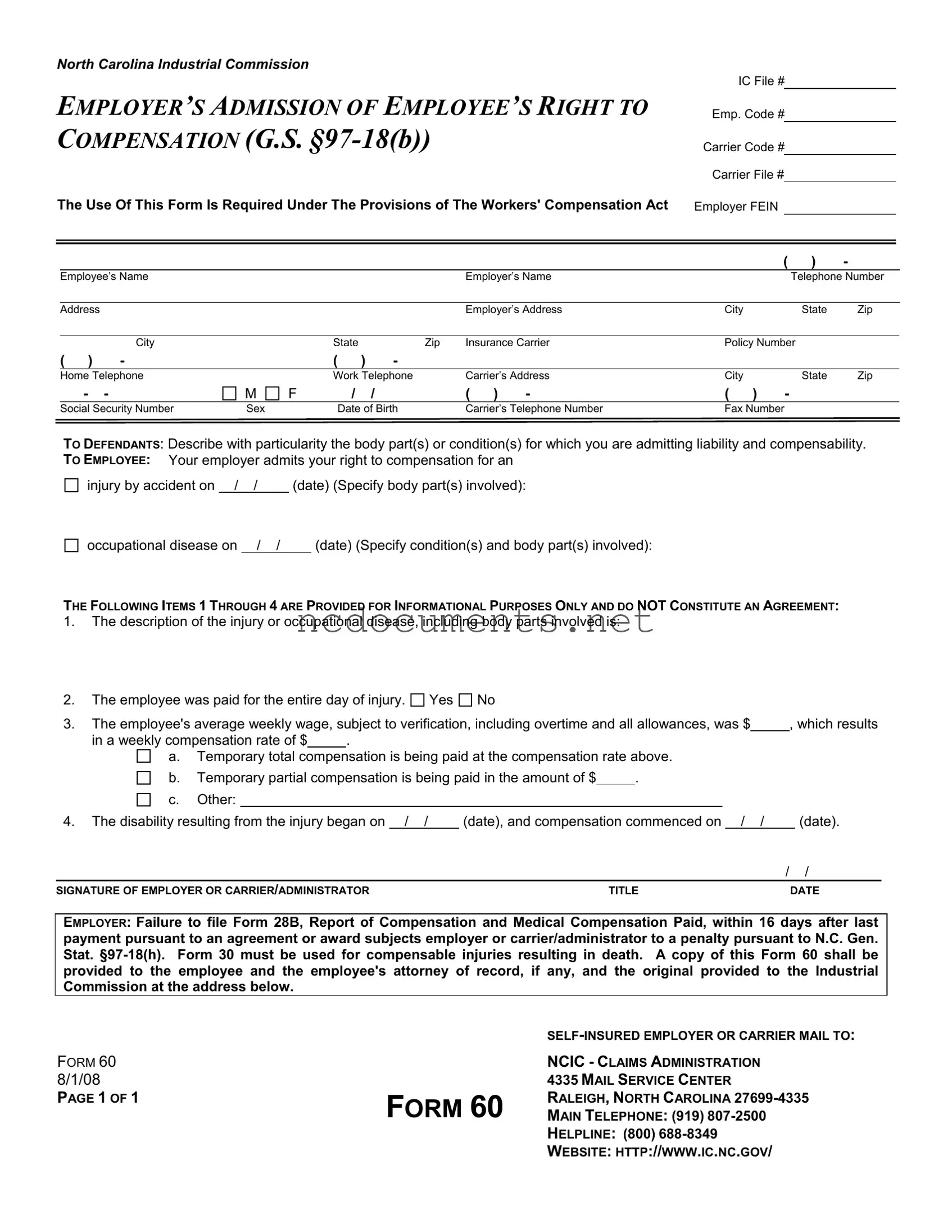The North Carolina Form 28B serves a similar purpose to the North Carolina Form 60 in the context of workers' compensation. This form is used by employers to report compensation and medical benefits that have been paid to an employee following a work-related injury. Like the Form 60, it requires detailed information about the employee, the nature of the injury, and the compensation provided. Both forms are essential for maintaining accurate records and ensuring compliance with state laws regarding workers' compensation.
The Form 30 is another document that parallels the North Carolina Form 60, particularly in cases involving fatal work-related injuries. This form is used to report a compensable injury that results in the death of an employee. It outlines the circumstances of the incident and the compensation due to the dependents of the deceased. Both forms highlight the employer's acknowledgment of liability and the need to provide necessary compensation, although the Form 30 focuses specifically on death claims.
Form 19, the Employer's Report of Injury to Employee, is also similar to the Form 60. This document is typically filed by the employer to report an injury that has occurred in the workplace. It includes information about the employee, the nature of the injury, and the circumstances surrounding it. While Form 60 admits liability and outlines compensation, Form 19 serves as an initial report that helps initiate the claims process.
When engaging in the buying or selling of personal property, it is crucial to ensure that all necessary documentation is completed accurately. The All Colorado Documents provide valuable resources that facilitate this process, helping individuals navigate the complexities of legal transactions in a straightforward manner.
The Form 18, which is the Employee's Notice of Accident to Employer, shares similarities with the Form 60 as it is crucial for the claims process. This form is filled out by the employee to notify the employer about a work-related injury. It includes information about the employee, the injury, and the circumstances of the accident. Both forms are integral to ensuring that the claims process is initiated correctly and that all parties are informed of the situation.
Form 21, the Agreement for Compensation for Disability, is another document that aligns with the North Carolina Form 60. This form is used when the employer and employee agree on the compensation amount for a work-related injury. It formalizes the agreement and ensures that both parties understand the terms of compensation. While Form 60 admits liability, Form 21 solidifies the agreement on compensation, making both forms important in the claims process.
The Form 26, which is a Notice of Change of Compensation, is similar in that it is used to communicate changes in the compensation being paid to an employee. This form is crucial when there are adjustments to the benefits due to changes in the employee's condition or work status. Both the Form 60 and Form 26 serve as official documents that help maintain clarity and transparency in the compensation process.
Form 28, the Employer's Report of Compensation and Medical Compensation Paid, is comparable to the Form 60 as it provides a detailed account of the compensation and medical benefits paid to the employee. This form is essential for tracking the payments made and ensuring compliance with workers' compensation laws. Both forms aim to provide a clear record of what has been paid and what is owed to the employee.
The Form 30R, which is a Request for Hearing, is another document that shares a connection with the Form 60. While Form 60 admits liability, the Form 30R is used when there is a dispute regarding compensation or benefits. This form initiates a formal hearing process to resolve disagreements. Both forms play critical roles in the workers' compensation system, ensuring that employees receive the benefits they are entitled to while also providing a mechanism for dispute resolution.
Form 33, the Request for Hearing on Claim, is similar in function to the Form 30R. This form is filed when an employee seeks a hearing regarding their claim for benefits or compensation. It serves as a formal request to the Industrial Commission to review the case. Both Form 33 and Form 30R are essential for addressing disputes and ensuring that employees have a fair opportunity to present their claims.
Lastly, the Form 60 is akin to the Form 19B, which is the Employer's Report of Work-Related Injury for Occupational Diseases. This form is used to report cases of occupational diseases, similar to how Form 60 addresses injuries. Both documents require detailed information about the employee and the conditions related to the claim. They are vital for ensuring that employees receive appropriate compensation for their work-related health issues.
